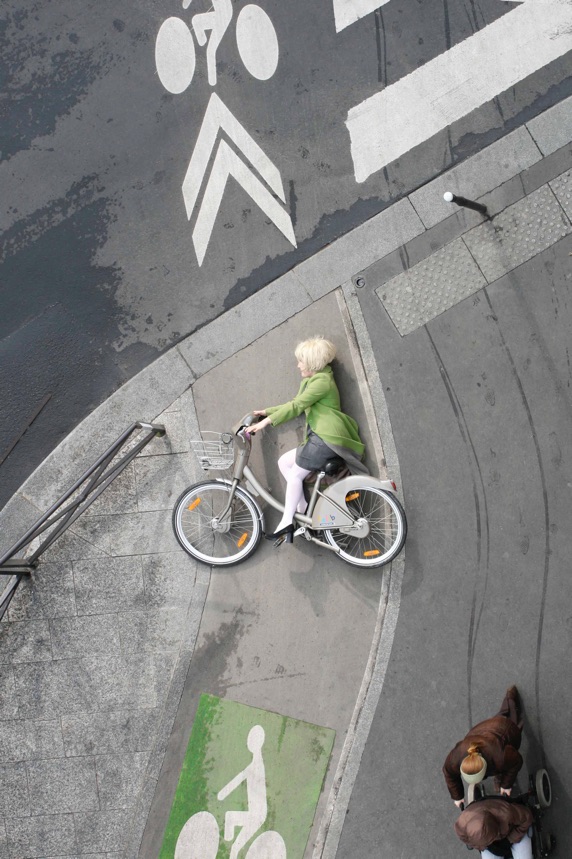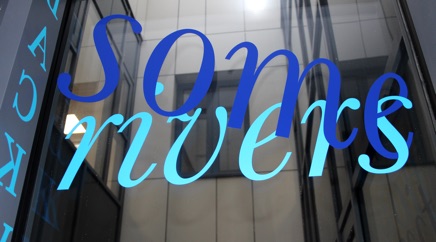Conversation between art and architecture has been, for the last four years, a constant concern of our site specific work and often we begin by looking at works from history that have served as our particular references. The Italian masters in particular developed sophisticated strategies to integrate in situ paintings into an architectural context. Di sotto in sù - literally “seen from below”- transformed ceilings into pictorial space above our heads, a view through into a heavenly space beyond, unapologetically combining christian and pagan imagery to invent a sensuous weightless world. Quadratura used the weight of architecture as counterpoint to this painterly lightness - allowing the painting to invade the framing architecture which in turn was brought into the pictorial space. If this tradition survived into the modern world, it was as dream-space in the work of Marc Chagall, and later as the soft nightmares of René Magritte. In the media of the contemporary world, reality has caught up with dreams: Yves Klein’s photographic Leap into the Void exploits our belief that cameras never lie, and the hyper-realist CGI of Alfonso Cuarón’s Gravity depicts a gravity-free world where the weight of Baroque architecture is replaced by the heavy engineering of spacecraft around which float bodies protected by the hi-tech fabric of spacesuits.
How to reconcile these historic inspirations with the concerns of contemporary society? For this challenge we ask for the help and participation of the community - that occupies (or will occupy) a building of glass, steel and concrete - in the creative temporal process of making a permanent in situ work that integrates art into architecture. We pay particular attention to the point of view of the spectator using, in our most recent projects, anamorphosis which derives from the same renaissance perspective techniques with which we began.
Anne Cleary & Denis Connolly, October 2014
Our recent work has centred on the art of looking: inviting people to change the way that they look at the world around them, and to consider how important their particular perspective is to how they understand the world. We have asked people to consider their two eyes and to do different things with them. We have explored other ways of looking, from the animal kingdom and elsewhere, and we have listened to and read and discussed much of what others have to say about looking…
What have we learnt?
Perhaps the most important thing is that looking is not just about eyes: it involves both mind and body. Indeed when we look at things we look with our whole bodies, which move around the object of our gaze while our heads turn about and we take things in our hands to examine them more closely. Indeed, when our two eyes dart about scanning details, it is our mind that is working, interrogating the world, filling in colour and detail that we have barely glanced, building models using current and remembered sensory data.
The complexity of the act of looking reminds us of how central it is to what we are. So many of the brain’s connections are about directing/processing this continuous action, at once physical and cerebral. Man the Observer is perhaps what the hunter-gatherer-that-we-were has been becoming for millennia.
We will continue to explore how other animals see and the new ways of seeing that technology can offer us, but our central mission is to make people aware of their own eyes and to remind them that the art of looking is central to what we are, and even essential to our happiness on the earth.
Anne Cleary & Denis Connolly. September 2017
Psycle Path. Photograph, 2007
Hi Denis
Here's an instinctive reaction to what you say. Not reasoned at all, just from the gut.
You each have limited creative time available to you. But the time already gone has not been wasted: you are full of the wisdom of life. As artists you are therefore now at your most fertile.
Because art is the life you have chosen, you must make the most of this moment. Your idea of observer participation can lead you where you need to go. Machado wrote: Traveller, there is no path; the path is made by walking. Art in its sublime form is a process of walking together whereby the artist and observer together transform themselves and each other.
In a way it doesn't matter if you stay with helmets, or take your practice back into the built environment, or anywhere else. What matters for you now, in this peak of artisitic fertility, is your capacity to transform: yourselves, each other, and those who immerse themselves in your work. You should not be satisfied with superficial impressions - with small detours as it were from well trodden paths. Spiritually and culturally, as well as politically, socially and economically, those paths are in danger of leading us towards the wasteland. Your artistic mission should be to help us all find the way to a better place.
I still have in my study the great, revered textbook by John Wheeler on Gravitation (Misner, Thorne and Wheeler, as it was known to generations of physics students). After Einstein died, Wheeler became the world authority on general relativity. But I was never convinced by the argument (which came not from relativity but the Copenhagen interpretation of quantum mechanics) that there is no reality independent of the observer. And even if it's true in the quantum world, it was then hijacked and misapplied by the evil postmoderninsts and constructivists who must bear some of the responsibility for our current predicament.
The final chapter of Carlo Rovelli's wonderful little book "Seven Brief Lessons on Physics" is brilliant on the natural science part of this.
But your notion of observer participation stands on its own terms as an essential principle for art, with no need of buttressing by physics.
Written in haste - forgive me if any of this is obscure, clumsy or infelicitous!
As always
John
Two studies for helmets, 2015. Left, the Complementary, and, right, the Gecko.
Run River Run, University Hospital Galway, 2017
An email from John Ashton, 18 October 2016









